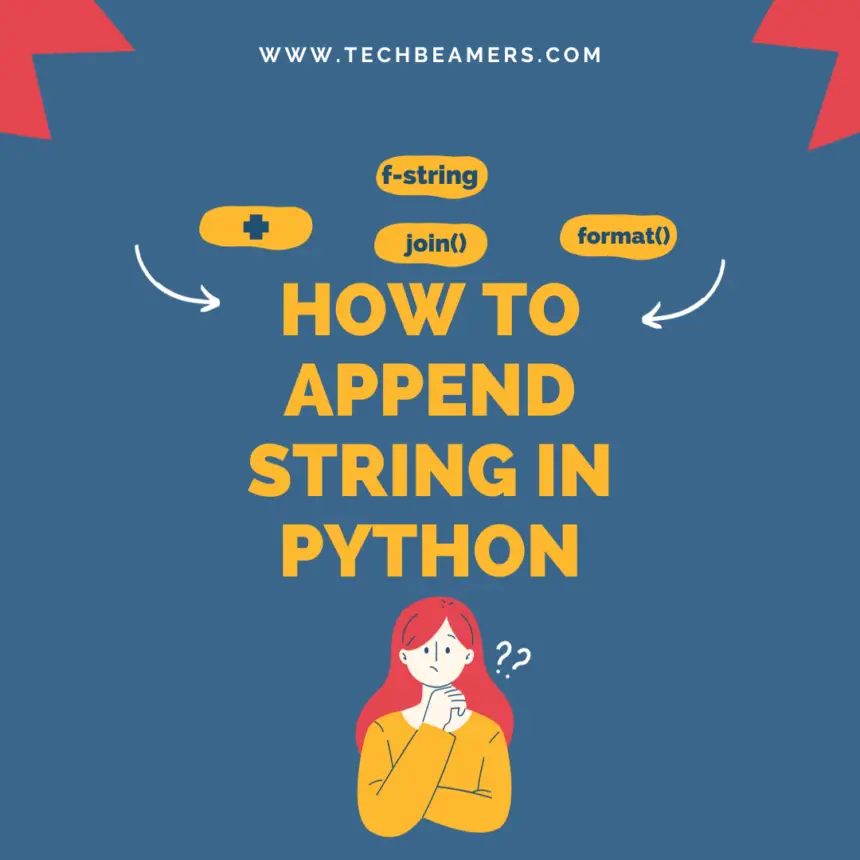This tutorial deep dives into how Python appends strings using different ways. Appending a string in Python means adding one string to the end of another string. This is a common task in programming, and there are a few different ways to do it in Python.
Introduction to Different Methods to Append Strings in Python
This tutorial will cover the following methods for appending strings in Python:
- Using the + operator
- Using the join() method
- Using the string.format() method
- Using f-strings
The tutorial will also include a table comparing the different methods and advising which is the most suitable for different situations.
1. Using the + operator
The + operator can be used to append two strings together. For example, the following code will append the string ” world!” to the end of the string “Hello”:
Also Read: How to Use XOR Operator in Python
Python code:
string1 = "Hello"
string2 = " world!"
# Append string2 to the end of string1
string1 += string2
# Print the new string
print(string1)
Output:
" Hello world! "
The + operator can also be used to append multiple strings together. For example, the following code will append the strings ” world!” and “!” to the end of the string “Hello”:
Python code:
string1 = "Hello"
string2 = " world!"
string3 = "!"
# Append string2 and string3 to the end of string1
string1 += string2 + string3
# Print the new string
print(string1)
Output:
" Hello world! "
2. Using the join() method to append strings in Python
The Python join() method can be used to append a list of strings together. The join() method takes two arguments: a separator string and a list of strings. The separator string is inserted between each string in the list.
For example, the following code will append the strings ” world!” and “!” to the end of the string “Hello” using the join() method:
Python code:
string1 = "Hello"
string2 = " world!"
string3 = "!"
# Create a list of strings
strings = [string1, string2, string3]
# Append the list of strings together using the join() method
string1 = "".join(strings)
# Print the new string
print(string1)
Output:
" Hello world! "
The join() method is a more efficient way to append multiple strings together than using the + operator. This is because the join() method only creates one new string, while the + operator creates a new string for each concatenation operation.
3. Using the string.format() method
Usually, the purpose of the string.format() method is for formatting strings with values from variables. However, we can utilize it to append strings in Python. It takes two arguments: a format string and a dictionary of values. The format string is a string that contains placeholder markers, which are replaced with the values from the dictionary.
For example, the following code will append the strings ” world!” and “!” to the end of the string “Hello” using the string.format() method:
Must Read: Python String Format Explained with Examples
Python code:
string1 = "Hello"
string2 = " world!"
string3 = "!"
# Create a dictionary of values
values = {
"string2": string2,
"string3": string3
}
# Append the strings to the end of string1 using the string.format() method
string1 = string1.format(**values)
# Print the new string
print(string1)
Output:
" Hello world! "
The string.format() method is a more flexible way to append strings together than the + operator or the join() method. This is because of the string.format() method allows you to insert variables into the string.
4. Using f-strings
f-strings are a new way to format strings in Python 3.6 and later. f-strings are similar to the string.format() method, but they are more concise and easier to read.
For example, the following code will append the strings ” world!” and “!” to the end of the string “Hello” using an f-string:
If interested to learn more in-depth, have a deeper look at the Python f-string tutorial.
Python code:
string1 = "Hello"
string2 = " world!"
string3 = "!"
# Append the strings to the end of string1 using an f-string
string1 = f"{string1}{string2}{string3}"
# Print the new string
print(string1)
Output:
" Hello world! "
f-strings are a convenient way to append strings together, especially when you are appending values from variables.
Also Read: Python String Strip Tutorial
Which method should I use?
The best method to use for appending strings in Python depends on the situation
Which method should I use?
The best method to use for appending strings in Python depends on the situation. Here is a table comparing the different methods and advising which is the most suitable for different situations:
| Method | Advantages | Disadvantages | Best suited for |
|---|---|---|---|
| + operator | Simple and concise | Concise and easy-to-read | Appending two or three strings together |
| join() method | More efficient for appending multiple strings together | Can be less readable than using the + operator | Appending multiple strings together |
| string.format() method | Flexible and allows you to insert variables into the string | Can be less concise than using the + operator or f-strings | Appending strings together and inserting variables into the string |
| f-strings | Concise and easy to read | Only available in Python 3.6 and later | Appending strings together and inserting variables into the string (in Python 3.6 and later) |
Example code snippets with fresh and enriched examples
The following code snippets show how to use the different methods to append strings in Python with fresh and enriched examples:
Python code:
# Using the + operator
# Append the string " world!" to the end of the string "Hello"
string1 = "Hello" + " world!"
# Append the strings " world!" and "!" to the end of the string "Hello"
string2 = "Hello" + " world!" + "!"
# Print the new strings
print(string1)
print(string2)
Output:
Hello world!
Hello world!
Python code:
# Using the join() method
# Create a list of strings
strings = ["Hello", " world!", "!"]
# Append the list of strings together using the join() method
string3 = "".join(strings)
# Print the new string
print(string3)
Output:
Hello world!
Python code:
# Using the string.format() method
# Create a dictionary of values
values = {
"string1": "Hello",
"string2": " world!",
"string3": "!"
}
# Append the strings to the end of string1 using the string.format() method
string4 = string1.format(**values)
# Print the new string
print(string4)
Output:
Hello world!
Python code:
# Using f-strings
# Append the strings to the end of string1 using an f-string
string5 = f"{string1}{string2}{string3}"
# Print the new string
print(string5)
Output:
Hello world!
Also Check: Different Ways to Concatenate Strings in Python
Conclusion – Different Ways to Append Strings in Python
There are a few different ways to append strings in Python. The best method to use depends on the situation. The + operator is simple and concise, but it can be inefficient for appending multiple strings together. The join() method is more efficient for appending multiple strings together, but it can be less readable than using the + operator. The string.format() method is flexible and allows you to insert variables into the string, but it can be less concise than using the + operator or f-strings. f-strings are concise and easy to read, but they are only available in Python 3.6 and later.
We hope this tutorial has been helpful. Please let me know if you have any other questions.









